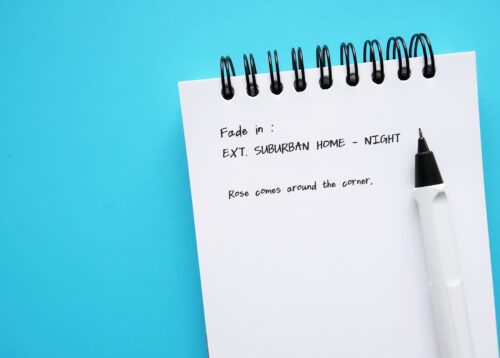Knowing how to format a script is the first and most crucial step in bringing your creative vision to life. A script format is one of the most powerful instruments in a writer’s toolkit. It can transform your lightbulb moments into a structured, compelling narrative. Whether you’re writing YouTube scripts or podcast intro scripts, understanding the industry standards for a script-writing format is key to creating cinematic masterpieces.
At Voice123 – where we’ve put together free script resources – we know all audio/visual productions start with a script. So, here we’ll explore how to format a script for plays, movies, and TV.
Are you ready to learn how to format a script that goes from scenes to screens?
What is a script format?

A script format defines the layout and formatting standards, character details, transitions, dialogue and action, and scene and stage directions for screenplays and scripts in video games, TV shows, plays, movies, and other productions. When it comes to video production, knowing how to format a script will help you create a visually appealing script with clear, concise, and easy-to-follow content. But there’s also special software that can help format your script to industry standards. Final Draft and Celtx are popular screen-writing tools that apply automatic formatting to scenes and dialogue.
Here’s our complete guide on how to format a script.
How to format a script
1. Create a title page
Your title page must include the title, writer’s name, logline, and contact information. Center the title in full caps and use sentence casing for the rest of the text. Example:
SHADOWS OF JUSTICE
By John Smith
An idealistic lawyer is torn between legal victory and believing his client is guilty.
2. Structure each page and scene
Use a standard script format template or writing software to help arrange your information according to industry guidelines. Example:
- 12-point Courier font
- 1.5-inch left margin
- 1.0–1.25-inch right margin
- .5-1-inch top and bottom margin
- 2.5-inch dialogue block centered from the left margin
- 3.5-inch character name centered from the left margin
- INT. or EXT. to define if the area is interior or exterior
3. Outline character dialogue
The character’s name must always be capitalized and appear one line above their dialogue. Use parentheses for line delivery instructions next to the dialogue. Example:
DAVID
The evidence is circumstantial at best, so I think we have a strong case.
CLIENT
(menacingly) We’d better. I’m not paying you so I can end up in jail.
4. Describe actions and scenes
Write all action lines in the present tense with descriptive, concise wording. Position every new shot or focus on a new line. Example:
• David exits the courthouse.
• Reporters crowd the steps, shouting questions at David.
5. Insert transitions
Transitions like CUT TO: FADE TO: or DISSOLVE TO: indicate specific visual changes and convey time, location, and mood shifts. Example:
CUT TO: EXT. COURTHOUSE STEPS – The client smirks with each step.
How to format a play script
- A play script format must have a 12-point font like Courier, keeping 1-inch margins for notes and directions on all four sides.
- Write the act number in the top-left corner and center the scene number underneath it.
- Center and capitalize characters’ names above spoken lines and left-align the dialogue.
- Italicize stage directions and line delivery info in parentheses next to the dialogue.
- Right-align and bolden the lighting and sound cues and include specific timings.
How to format a movie script
- Start all new scenes with a slugline describing location and time. Use INT. and EXT. followed by location and time.
- Center and capitalize character names above their dialogue. Only use quotation marks for quotes or references.
- Use parentheses for line delivery instructions, writing it under the character’s name and above the dialogue.
- Use transitions to indicate scene changes if necessary, and align them to the right of the page.
- Include important camera shots in full caps, like ANGLE ON or CLOSE UP.
How to format a TV script
- Include the show, episode, writer’s name, contact information, and draft version or date on the title page.
- All new scenes must have a scene heading or slug line with INT. or EXT. and the location and time.
- Start each new TV script format with a TEASER scene. This short opening scene sets the episode’s tone, genre, and conflict.
- Center the act and scene numbers in a TV script format and italicize stage directions in parentheses.
- Use parentheses to describe character line deliveries; write them under the name above the dialogue.
How to format a voice over script

- Use clear, professional fonts like Arial or Times New Roman, size 12, to ensure script readability.
- Include a pronunciation guide for unusual words the voice actor must read.
- Mark pauses with an ellipsis (…) for a brief pause, or note the length of the pause if it’s extended [pause: 5 sec.]
- Use boldface or italics to indicate words that need precise emphasis during the voice over.
- Write descriptors in brackets next to the corresponding text for tone and pitch changes (speak in a whispering tone).
Final thoughts
A script format template is more than just parentheses and italicized instructions. Understanding how to format a script helps screenwriters of all industries communicate their vision to directors, actors, and producers. From video games to comic book scripts, the right script format can take your stories from page to stage (or screen).
And when it’s time to add intriguing voice overs to your project – work with our exceptional vocal talent on Voice123 or hire our professional Managed Services to handle your project from A to Z.
Now it’s your turn to craft cinematic magic with script-writing formats!
FAQs
The format is a standardized structure that organizes screenplays, stage plays, or broadcast scripts. Its elements include scene headings, action lines, character names, and dialogue.
These are film and TV screenplays, theater stage plays, and radio and TV broadcast scripts.
It’s a pre-formatted document outlining a script’s structure and elements. The template is a guide for writers to ensure consistency across the industry.
It’s a three-act format, including setup, the character and world introduction, confrontation, the central conflict and obstacles, and resolution, which is the climax and conclusion. Other elements include scenes, sequences, and dialogue.































